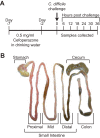Dynamics and establishment of Clostridium difficile infection in the murine gastrointestinal tract
- PMID: 25534943
- PMCID: PMC4333439
- DOI: 10.1128/IAI.02768-14
Dynamics and establishment of Clostridium difficile infection in the murine gastrointestinal tract
Abstract
Clostridium difficile infection (CDI) following antibiotic therapy is a major public health threat. While antibiotic disruption of the indigenous microbiota underlies the majority of cases of CDI, the early dynamics of infection in the disturbed intestinal ecosystem are poorly characterized. This study defines the dynamics of infection with C. difficile strain VPI 10463 throughout the gastrointestinal (GI) tract using a murine model of infection. After inducing susceptibility to C. difficile colonization via antibiotic administration, we followed the dynamics of spore germination, colonization, sporulation, toxin activity, and disease progression throughout the GI tract. C. difficile spores were able to germinate within 6 h postchallenge, resulting in the establishment of vegetative bacteria in the distal GI tract. Spores and cytotoxin activity were detected by 24 h postchallenge, and histopathologic colitis developed by 30 h. Within 36 h, all infected mice succumbed to infection. We correlated the establishment of infection with changes in the microbiota and bile acid profile of the small and large intestines. Antibiotic administration resulted in significant changes to the microbiota in the small and large intestines, as well as a significant shift in the abundance of primary and secondary bile acids. Ex vivo analysis suggested the small intestine as the site of spore germination. This study provides an integrated understanding of the timing and location of the events surrounding C. difficile colonization and identifies potential targets for the development of new therapeutic strategies.
Copyright © 2015, American Society for Microbiology. All Rights Reserved.
Figures






References
Publication types
MeSH terms
Substances
Grants and funding
LinkOut - more resources
Full Text Sources
Other Literature Sources
Molecular Biology Databases

